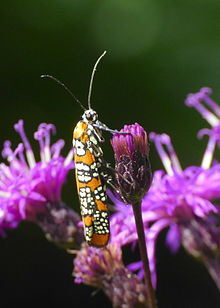Ailanthus webworm
| Ailanthus webworm | |
|---|---|

| |
| Atteva aurea feeding on Vernonia gigantea | |
| Scientific classification | |
| Domain: | Eukaryota |
| Kingdom: | Animalia |
| Phylum: | Arthropoda |
| Class: | Insecta |
| Order: | Lepidoptera |
| Family: | Attevidae |
| Genus: | Atteva |
| Species: | A. aurea
|
| Binomial name | |
| Atteva aurea (Fitch, 1856)
| |
| Synonyms | |
| |
The ailanthus webworm (Atteva aurea) is an ermine moth now found commonly in the United States.[1][2] It was formerly known under the scientific name Atteva punctella (see Taxonomy section). This small, very colorful moth resembles a true bug or beetle when not in flight, but in flight it resembles a wasp.[3]
Host plants
[edit]The ailanthus webworm is thought to be native to South Florida and the American tropics (south to Costa Rica), which were the habitat of its original larval host plants: the paradise tree (Simarouba glauca) and Simarouba amara.
Another tree called tree-of-heaven, (Ailanthus altissima), originally from China, has been widely introduced into landscapes and invaded into natural areas where Atteva aurea has been able to adapt to this new host plant, giving rise to its common name.
Ailanthus altissima is considered an invasive species, although it is still sold by nurseries as a yard plant, mainly because it is one of the few species that will grow in highly polluted or otherwise difficult places. Atteva aurea can be a minor pest in nurseries, although it rarely does serious damage.

Climate
[edit]This tropical moth is commonly seen in summer throughout the continental US, and occasionally eastern Canada (its northern limit is eastern Ontario and south-western Quebec beyond the host range). This species appears to be either adapting to colder areas, or staying further north due to changing climates.[4]
Life cycle
[edit]Larvae produce nests on the host plant by pulling two or more leaflets around a network of loose webbing. Then they consume the leaflets and bark. The caterpillars have a wide, light greenish-brown stripe down their backs and several thin, alternating white and olive-green stripes along their sides. The range of colors is from light brown to dark black. The adult moth visits flowers, is diurnal, and is a pollinator. The life cycle from egg to egg can happen in four weeks. Due to this being a species from warmer areas, it lacks a diapause stage. Larvae can be found from mid-spring to a hard freeze. There may be many generations each summer with eggs being laid on the webs of other larvae. This can result in a communal web that has multiple generations - from eggs to various larva stages to pupae. Mating happens in the mornings with egg-laying apparently happening in the evening. Eggs are found individually, not in clusters, even though each web may contain many separate eggs.[5]
Taxonomy
[edit]-
Atteva edithella, now considered a synonym of Atteva aurea
-
Atteva exquisita, now considered a synonym of Atteva aurea
-
Atteva ergatica, now considered a synonym of Atteva aurea
-
Atteva microsticta, now considered a synonym of Atteva aurea
Wilson et al. (2010) discovered that morphologically similar Attevid moths were assigned two different names, Atteva ergatica in Costa Rica and Atteva punctella in North America, but had identical DNA barcodes.[6][7][8][9][10][7][11]
References
[edit]- ^ "Ailanthus Webworm - blandy". blandy.virginia.edu. Retrieved 2019-06-01.
- ^ "Species Atteva aurea - Ailanthus Webworm Moth - Hodges#2401 - BugGuide.Net". bugguide.net. Retrieved 2019-06-02.
- ^ "Ailanthus Webworm Moth". www.insectidentification.org. Retrieved 2019-06-01.
- ^ "Ailanthus Webworm Moth Atteva aurea (Cramer, 1781) | Butterflies and Moths of North America". www.butterfliesandmoths.org. Retrieved 2019-06-01.
- ^ "Bugs in Orange and Black, Part I: An ermine moth, ailanthus webworm, Atteva aurea". Bug of the Week. Retrieved 2019-06-01.
- ^ "Maryland Biodiversity Project - Ailanthus Webworm Moth (Atteva aurea)". www.marylandbiodiversity.com. Retrieved 2019-06-01.
- ^ a b Wilson, John James; Landry, Jean-François; Janzen, Daniel; Hallwachs, Winnie; Nazari, Vazrick; Hajibabaei, Mehrdad; Hebert, Paul (2010). "Identity of the ailanthus webworm moth (Lepidoptera, Yponomeutidae), a complex of two species: evidence from DNA barcoding, morphology and ecology". ZooKeys (46): 41–60. doi:10.3897/zookeys.46.406.
- ^ Heppner, John B.; Duckworth, W. D. (1983). "Yponomeutidae". In Hodges, Ronald W.; Dominick, T.; Davis, Donald R.; Ferguson, D. C.; Franclemont, J. G.; Munroe, Eugene G.; Powell, Jerry A. (eds.). Check list of the Lepidoptera of America North of México. London: Classey. pp. 26–27.
- ^ Covell, C. V. (1984). A field guide to the moths of Eastern North America. Boston: Houghton Mifflin. pp. 1–496.
- ^ Heppner, John B. (1984). "Yponomeutidae". In Heppner, John B. (ed.). Atlas of Neotropical Lepidoptera. Checklist, Part I. The Hague: W. Junk. pp. 55–56.
- ^ Feinstein, Julie. "The Ailanthus Webworm Moth". Retrieved 2019-06-01.




